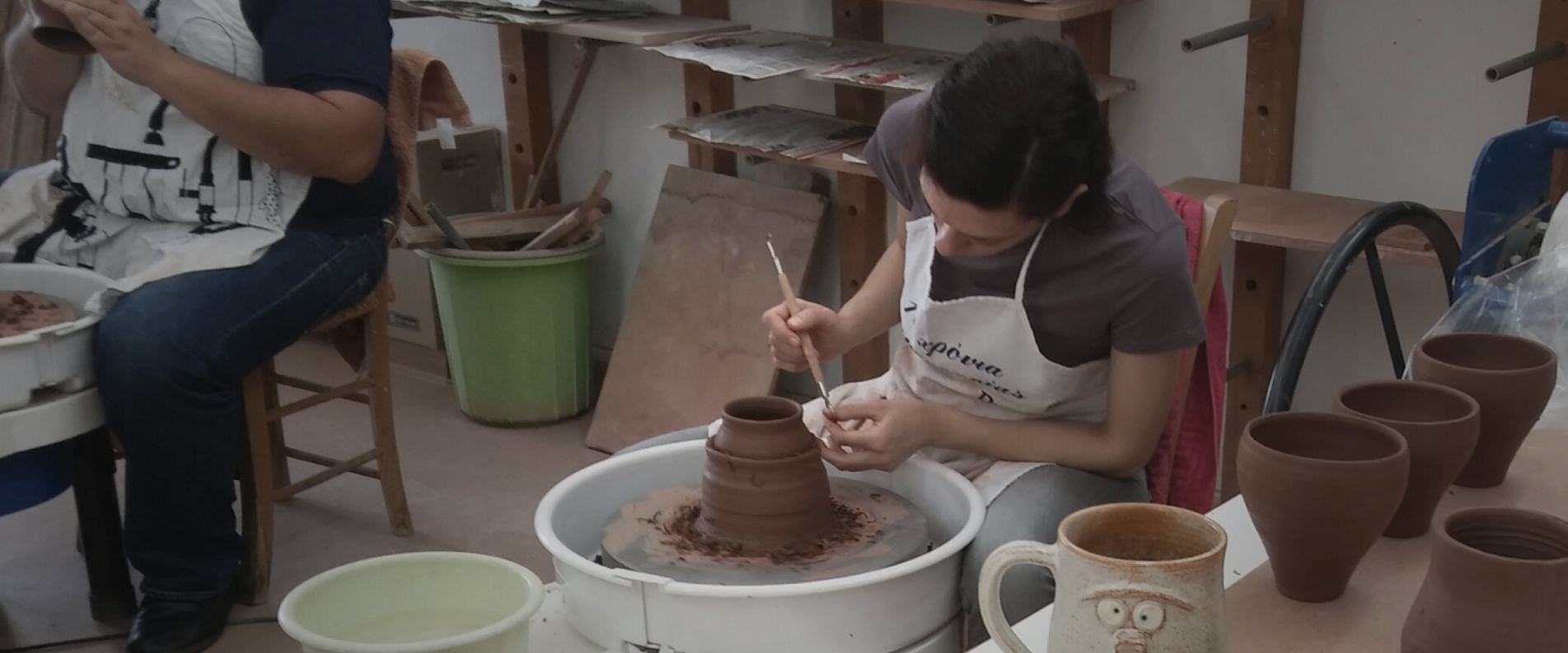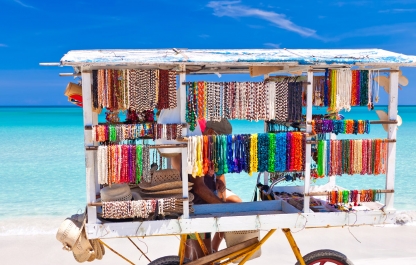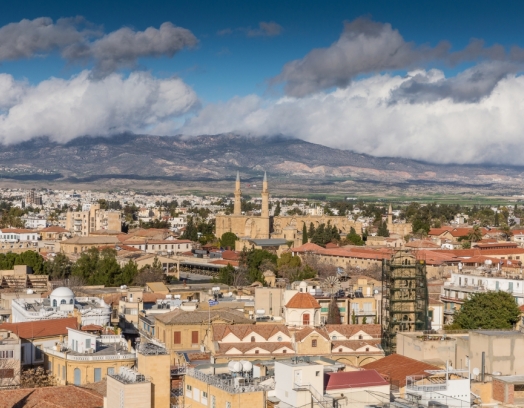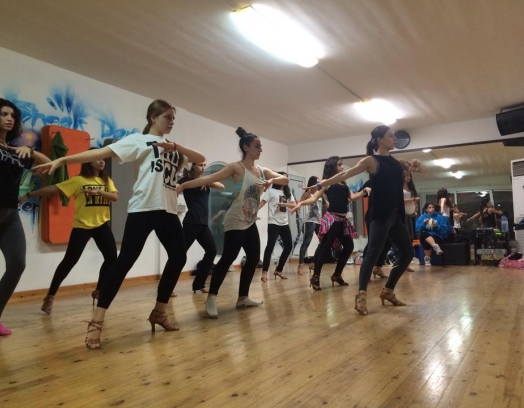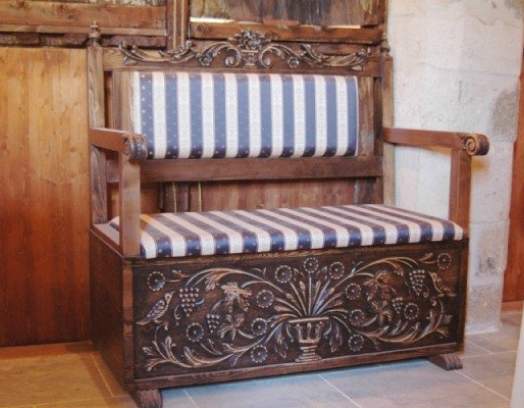Created and managed under the auspices of the Ministry of Commerce, Industry and Tourism, the Cyprus Centre of Craft has the main aim of reviving traditional Cypriot folk art and gradually developing it into a modern trade.
Today, Mrs Iro Evripidou Caleb is helping me to understand “how all this is arranged”. She has politely agreed to show and tell me about the place, its people and of course, the crafts which we will encounter within the Centre’s walls.
It was opened in 1979 after famous events, as a support and aid centre for Greek refugees, who had fled from many of the villages in the island’s northern regions.
We enter the Centre’s foyer, which has been decorated using the works of local skilled craftsmen. There’s an information stand on the way in, where you can find different booklets and other information on various types of folk trades, in Greek, English and Russian.
To the right, you can see an art crafts showroom, where you can purchase items identical to those manufactured in ancient times. These could be different decorative and practical household items, jewellery and utensils, which are still convenient for use in our time. All these wares will make your interior original or could be an unforgettable gift for your friends and loved ones. Besides, modern craftsmen, as representatives of both the old generation and very young generation — who have been inspired to inherit the skills and experience of their elders — often introduce contemporary notes to their works. This caters to the tastes and demands of the modern-day public while still preserving the tradition, character and uniqueness of the trades on display here.
All craftsmen wishing to work with the Centre and offering their works for sale must pass a quality check beforehand, as well as to ensure their wares conform with old techniques and the high standards observed by experts.
Located in the depths of the complex, surrounded by a multitude of workshops, as well as the Centre’s Museum, there is a garden — a genuine oasis, where you can take a pleasant break and reflect over the experiences you’ve enjoyed during your visit.
The Handicrafts Centre provides the following activities and services to its guests:
- Studying and conducting various examinations on traditional items of folk art.
- Manufacturing and developing the design of handicraft items.
- Perfecting all details in the production process.
- Conducting experimental works with new materials and techniques.
- Educating new craftsmen
- Production and sale (assisting in the sales distribution of products to all artisans, both male and female, from all of the island’s regions.
So, the most important thing now is to begin the process of “implanting” these trades into the centre. Mrs Iro and I walked together around this scenic garden of fragmented Cypriot traditions, surrounded by the other buildings in the Centre.
From time to time, my companion would open the doors to the workshops. Nowadays, almost 40 years after their founding, these hand-crafted works of beauty continue to exist and be created here, just like in the natural reserve. They’ve been multiplied by the experiences of countless generations, whose ability to detect natural beauty and masterfully use alternative materials, as well as natural resources, has become a priceless gift to their descendants [1].
The Workshops
Number One — The “kingdom” of the lacemakers: all kinds of lace (for instance, air, nodular weaving, created on a wooden shuttle — “a makoukoudi”, a variation of needle “tatting”). Embroidery (one type is cross-stitching, which Cypriot girls learnt before mastering needlework skills and so on). The crochet technique, still held dear to many today — All these are patterns created by women of different generations, in strict accordance with the “canon” and use of use well-known, centuries-old designs: asproplouma — the earliest embroidery technique in Cyprus, lefkaritika or “Cypriot white lace” [2]. You can see them used as decorations for textile works, which can only be described as stunning: tablecloths, covers and curtains, which today would, by no means, look out of fashion, but only add warmth, cosiness and originality to your home.
We pass through and look closely at the work of the female pupils while trying not to disturb the craftswomen who are teaching them.
As I’ve said above, all villages once widely renowned in Cyprus and beyond for the abilities of female residents, are on display here: in addition to Lefkara, Karavas, Omodos and others, which are well known to us. The primary colours of items are, by and large, natural or whitened cotton, though there are some decorated in a vibrant red — also traditional for Cyprus.

Number two — Weaving. While working on traditional looms, experienced weavers are reviving all types of fabrics, such as karpasitika and lefkonitsiatika, with their characteristic showiness, decor and bright colours. Then we have fithkiotika, featuring geometric patterns and motifs, as well as others. We were shown some ready-made table covers crafted according to this tradition, which had been made in Cyprus using cotton and a mix of fabrics: cotton with silk (always 50x50)… The inwoven patterns, as Mrs Iro stated, used to be multi-coloured (after visiting the Folk Art Museum in Nicosia, we know that since the Antiquity, the primary four colours used were: red, green, orange (yellow) and dark blue).
In the Messaoria valley, where the village folk would mainly occupy themselves with growing cotton and raising domestic cattle, weaves were developed from wool and cotton. The distinctive traits were striped, coloured fabrics on white backgrounds, with the use of striped patterns in traditional colours such as blue, dark red, yellow, orange and green.
Andrulla, a female artisan, now comes to join us: “as before, we weave panels of given sizes. However, if an item made to order, for instance, a bed cover, needs to have large measurements, then we warn our customers beforehand that it will have hand-woven panels joined together — everything as it was in the past”.
And so we approached a wooden yarn wound on a wooden drum — “an anemi”.
Naturally, upon the sight of silk, I “came to a halt” — how else was I supposed to react; after all, I’d been trying to find those few masters who still breed silkworms and hand-craft silk items for a long time [3]!
Although officially this trade once ceased industrial-scale production of silk, which strongly impressed travellers of the past: indeed, in past centuries, silk in Europe was a prerogative, a symbol of wealth and nobility; meanwhile in Cyprus, it was worn by all social classes…
As I had explained to me, even today, growing the cocoon and using these ancient techniques in production (let’s not forget, the main principle of the Centre is the manufacture of handmade items only!) requires a lot of effort and labour. “Silk” masters exist, however, and breed silkworms both to obtain the silk string (which, in fact, proved to be rougher than horsehair to the touch) and for the cocoons which are still used for decorative purposes.
Andrulla: “Were you surprised at how rough Cypriot silk is (she laughs)? Well, of course! To soften the finished product, I simply put it in water. The same applies to any of my works… Look, we’re growing a silkworm right here — it’s 2 weeks old at the moment. The caterpillars will later become pupae, creating a cocoon around themselves. Silk in Cyprus generally has two shades: white and yellow, depending directly on the type of caterpillar.
Once a year, in June-July, the Centre unwinds the silk from the cocoons… One thread, which you can see wound over a drum, has been obtained from 40 cocoons. Unravelling the thread requires particular precision and care [4]”.
They also gave me a demonstration of silkworm eggs, which are similar to grey poppy seeds: after all, as you recall from our previous accounts and meetings with craftsmen, a pinch of them was spread to every house for growing and producing silk.
Traditional “interior” fabrics are also produced here (used to make items for decorating locals’ houses). In actual fact, an enormous amount of patience and assiduity was necessary to make wool and cotton fabrics, with patterns and drawings lifted from traditional designs.
“Kourelloudes” — a type of woven rug — holds a special place here. This use to be considered one of the most essential crafts (it was developed in all villages of Paphos), in the form of covers laced at the edges.
Nowadays, similar items, of a somewhat smaller size than before, are manufactured on a loom and mainly intended for domestic use. The base of this rug type is made from a cotton thread with the aid of duck down, where old, coloured fabric is cut into strips and inwoven. Particular interest was directed to rugs from Phyti.
Weaves from Phyti and the neighbouring villages of Paphos were the most important for the long-standing history of this trade in Cyprus: even the ploumia design here (based on a rhombus) is identical to the ceramic samples from the geometric period, which have been famous since ancient times. This type of pattern weave was used in the manufacture of rectangular napkins, covers and tablecloths. Some other well-known “Phyti” patterns are the “little men, women”, “arks” and “the fish bone”.
“Phyti” has always been a part of a young Cypriot woman’s dowry when getting married. The quality and skills which the girl demonstrated, if she had made these things herself, could be used to assess the competence of her teacher, respectively. Trade was conducted from Nicosia, which became famous all over Cyprus for its female weavers. The more eastern lands, especially Karpathia, were renowned for the purple-red colour of their fabrics. Besides, Karpathia was also regarded as a textile centre, especially for creating fringed garments adorned with beads. This spot was also spoken of for manufacturing fabric with a particularly thick-weave pattern (πευκωτα), used for the outerwear of ceremonial dress. In the region of Morphou, especially in the Zodia community, linen yarn was produced, which was employed in sewing coats and bags for storing and transporting agricultural produce, as well as in the manufacture of Cypriot white embroidery and the lace embroidery “lefkaritika”. In the communities of Lapithos and Karavas, in the Kyrenia region, silk production was actively developed, along with the manufacture of silk fabrics: including the dry, thick-to-the-touch (διμητα).

The next is a wood workshop: Here, artisans demonstrate the exceptional levels of expertise in their trade by cutting pine and nut to fashion reliefs. Floral motifs are then woven into the pattern (flowers, grapevines, leaves and roses; as well as images of animals and birds — all of this can be seen on crockery shelves known as “souvantses”, mirror frames, chests and other furniture. The basic wood-carved motifs consist of birds (a symbol of love), lions — strength and power, the Cross (aside from the religious meaning of the Victim, it also refers to the Life cycle), angels (protectors and comforters to man). As we already know, wood carving was split into two divisions: the mundane and the ecclesiastical, both of which had several relief types.
In fact, in mundane carving, the social status and origin of the client played a large part in the choice of patterns, the level of expertise and their abundance on items of furniture, decor or utensils. Pine, nut, cedar and cypress were also used.
-
Number Four — the Ceramics workshop: here the creative process is in full swing — pupils, either under the instruction of their master or on their own, diligently work on a potter’s wheel, then decorate future items at a large table. Nearby the entrance stands a display case: as it turned out, not only do local craftsmen create their own, original pieces here, in which the old tradition of any given region (Lapithos, Kornos, Fini, Lefkara) continues to live on. In cooperation with the administrations of extensive collections of antiquities, both in Cyprus (the Cyprus Museum and others) and beyond (the Louvre and others), they skilfully manufacture modern replicas of antique ceramics. For instance, during my visit, several painted vessels stood out rather vividly behind the glass: they were definitely replicas of those from the age of “Cypriot geometry” (11-8 B.C.) and Crito-Mycenaean art (3,000-12 B.C). It also featured wares with a likeness to those manufactured millennia ago, under the influence of Egyptian art and relative recently — Byzantine art — in samples of glazed ceramics: a stunning collection of authentic pieces which decorate the exhibition at the Leventis Municipal Museum in Nicosia.
As such, by coming here and to other sections, we’re not only able to get acquainted with the fundamentals of these professions, but also obtain a good representation of their development in all centuries past; about the materials used by the master craftsmen who lived in any given age, in any given region. With ceramics especially, not only is it easy to distinguish regions by examining the design but even by visually noting the difference in the colour of the local clay: yellow and white meant Famagousta and Ammochostos, red — Kornos. Here, the main types of ceramic produced were: “haloumokouza” — tall pots “vases” for storing cheese; “kouzes” and “vattes” — medium and large-sized water vessels; “tzivertia” — cylindrical-shaped beehives for apiaries and so on) and Paphos, dark brown — Fini.
Fini, in fact, with an incredible history behind the development of this trade, is one of the four main centres which has existed for many centuries.
1. Laptithos (Kyrenia) — with ceramics traditionally covered with greenish enamel based on “badanou” a local type of clay;
2. Fini (items decorated with a multitude of human figures, birds and stucco images of flowers.
3. And 4. The famous Kornos and Ammochostos (where, aside from the main “assortment”, villagers produced money boxes, special-shaped vessels, ceramic sewage pipes and so on) with their white-yellowy clay from Deryneia and the Engomi vicinity.
-
Number five — metal art, including copper — icon crafting and massive points of income for Cyprus over the centuries. There is also a silver workshop here (it developed in Cyprus the same way as the wooden profession: split between the ecclesiastical and mundane). Here you will be taught how to manufacture decorative dishes and tanks with relief work and engraving; various jewellery with traditional motifs, such as artefacts from Kourion and on the frescoes of Paleo Paphos. There is also jewellery with modern motifs: an olive tree leaf (the artisan, when cutting leaves from an olive tree, incidentally makes replicas of them in silver — no single piece is ever the same!), as well as honeycombs, pairs of birds and others.
Let’s talk about several silver processing techniques, which have long been used in Cypriot jewellery art:
- Engraving — a method involving the use of etching tools to decorate table silver.
- Imprinting and stamping: at its core — hammering a silver plate on an anvil to further create an engraving. This type of decoration is known as “hollow work”. All details are applied after hammering the base plate.
- Perforation-cutting: a special fretsaw is used for maximum precision to cut out a pattern on a silver plate. Church plate, such as icon lamps, incense burners and others, is decorated with the aid of this technique.
- Filigree: as a rule, 92.5% silver is passed several times in a special apparatus known as a “syrtis”, which has many different-sized holes to give a determined shape. This openwork technique is often used in combination with enamel.
- Casting: this method is employed to make various products. Silver is melted and then used to fill moulds.
- Perforated casting: with the aid of this method, a jeweller treats workpieces as per the previous technique and by combining both these approaches, makes them more pronounced and vivid.
As in other workshops, for inspiration and greater visibility, the display cases feature samples of an stunning caribe from bygone or even the very oldest generations of Lefkara and other villages: wedding incense burners “kapnistomericha” (καπνιστομέρρεχα), medallions, necklaces and earrings, gilded knives for cutting paper and other things.
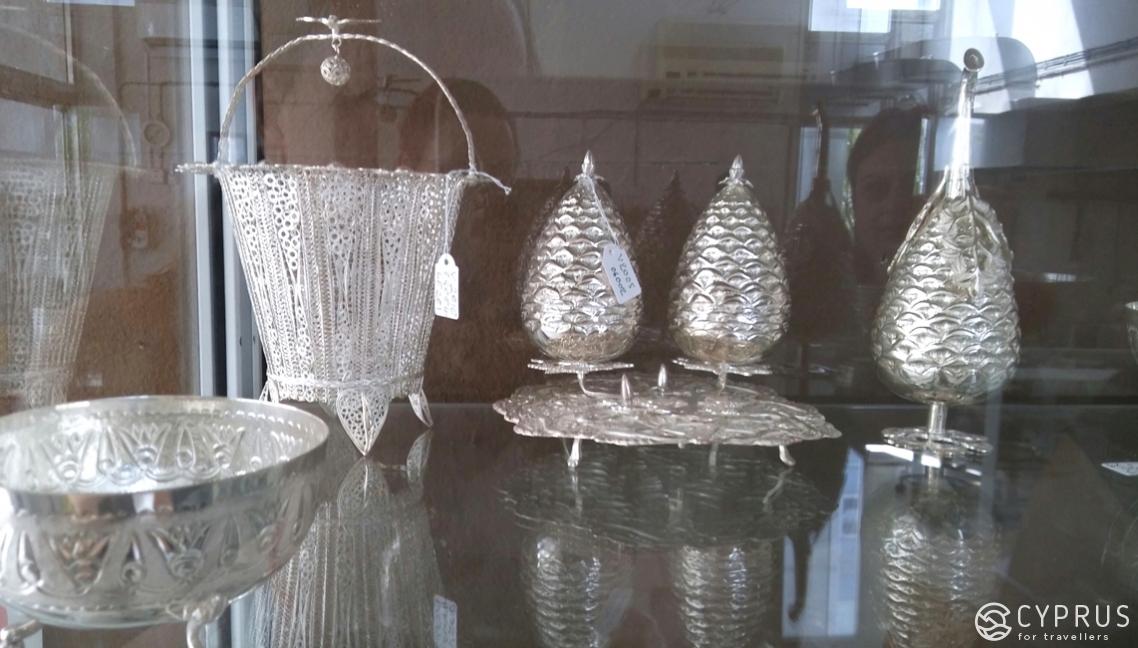
The time has come to open the sixth door, behind which those who practise the art of basket weaving work; also those who manufacture other items from vines, reed and straw. So, varying-sized baskets woven from twigs, which could be found everywhere in Cyprus, were primarily used to transfer potatoes, as well as grains and vegetables.
Here you will also come across weave samples from different regions, including “soft” baskets from Akrotiri. They were also intended for transporting grain and seeds; mats for covering roofs on huts and houses belonging to the less wealthy, as well as for other purposes.
As for straw, it was used to weave various trays and sieves, with different “designs” and woven patterns.
On the workshop walls, visitors will notice the most renowned tstestos. These are trays (like the rest of traditional items, they haven’t changed over the centuries) on which Easter flaounes, bread-koulouri (like a wedding invitation or an Easter treat) and other local food prepared at large-scale celebrations, were served. Nowadays during the week, as was done in the past, they are simply used as wall decorations. A variation of these trays — a psatharounda — was a rectangular-shaped decorative piece manufactured from a combination of straw and textiles.
There are also hanging baskets in which karavai bread was stored away from rodents and insects. Moreover, regardless of the form which the future items were to take, the main instrument for vine weavers is still only a standard knife.
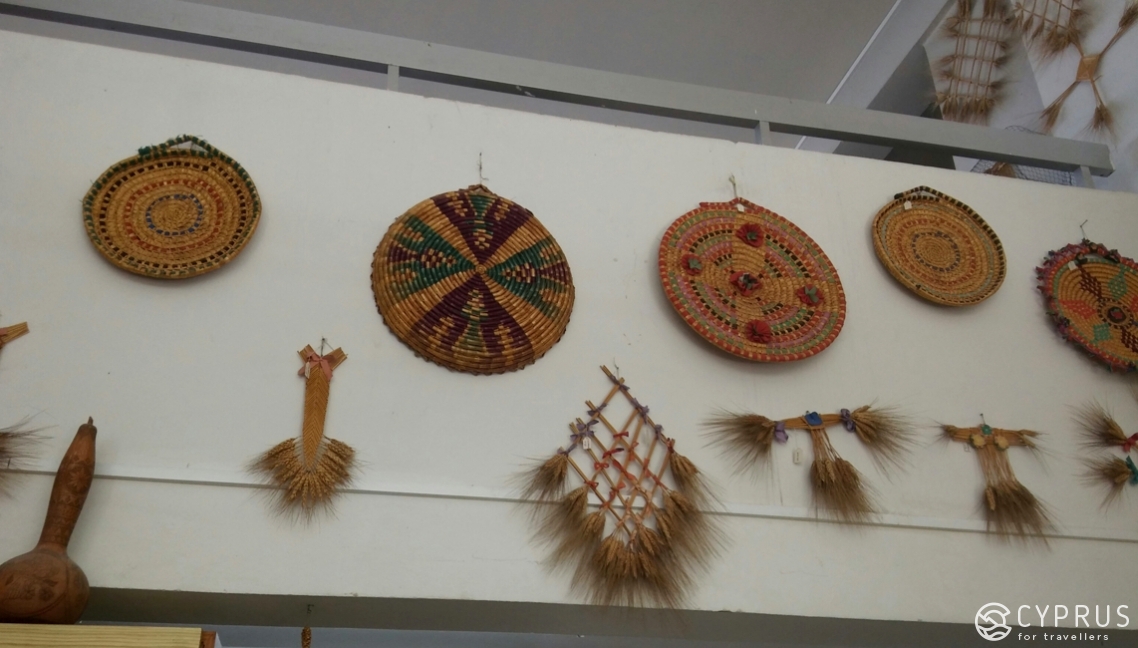
Amongst others, there is another decorative craft — carving pumpkin bottles, which are well known in many countries for being used as a water or wine flask (by cutting the top out of a ripened pumpkin, removing the seeds and cleaning it inside. Then, to ensure it is as waterproof as possible, a unique solution based on “pisa” is applied, which upon cooling on the walls and “neck” of the fruit, turns into a glass-like layer with a carmine-red colour). The patterns resemble lefkaritika and other recognisable geometric motifs.
To begin with, craftsmen make thin carvings into the pumpkin with a blade. Then, after smearing it with vegetable oil, the pumpkin is baked in an oven so that the drawing darkens and begins to contrast with the background.
There’s also another workshop located here, which produces Batik items, macrame lace and mosaics (glass, Italian smalt and natural stone — a small composition takes close to a month of work to complete). Also, there are panels created from silkworm cocoons and other skills for crafting different, small decorative ornaments and items for the interior.

The seventh door will open you up to the world of tanners and designers who, by and large, make accessories from goat’s leather: bags (chamois or in combination with textiles and leather), belts, luxury cosmetics, chamois frames for photos and organisers — the list is endless… all combined with a leather base consisting of laced elements and traditional fabrics.
The stand features traditional shepherds’ pouches — “vourkes” sewn from fully processed hides, which they would take with them when pasturing. There are also other bags and leather items.
Interestingly: the larger pieces of leather “tomaria” and “aski” were once used to manufacture bags for transporting wine; while the average-sized goat’s hide “kados” contributed to crafting baskets for carrying well-water. Near to the, you can see contemporary women’s designer bags in a hobo style, portraying the silhouette of the old works as a whole (and also traditionally fringed and decorated with beads).
Specially treated leather was employed in the manufacture of wedding diamond-tambourines or “tambourites”, which you can also encounter in the workshop, often covered with expert drawings and paintings.
Until the late 20th century, tanning was, interestingly, one of the main branches of handcraft in Cyprus (leather factories were called “gnafkia”). Naturally, this simple technique had its secrets, which were passed from father to son.
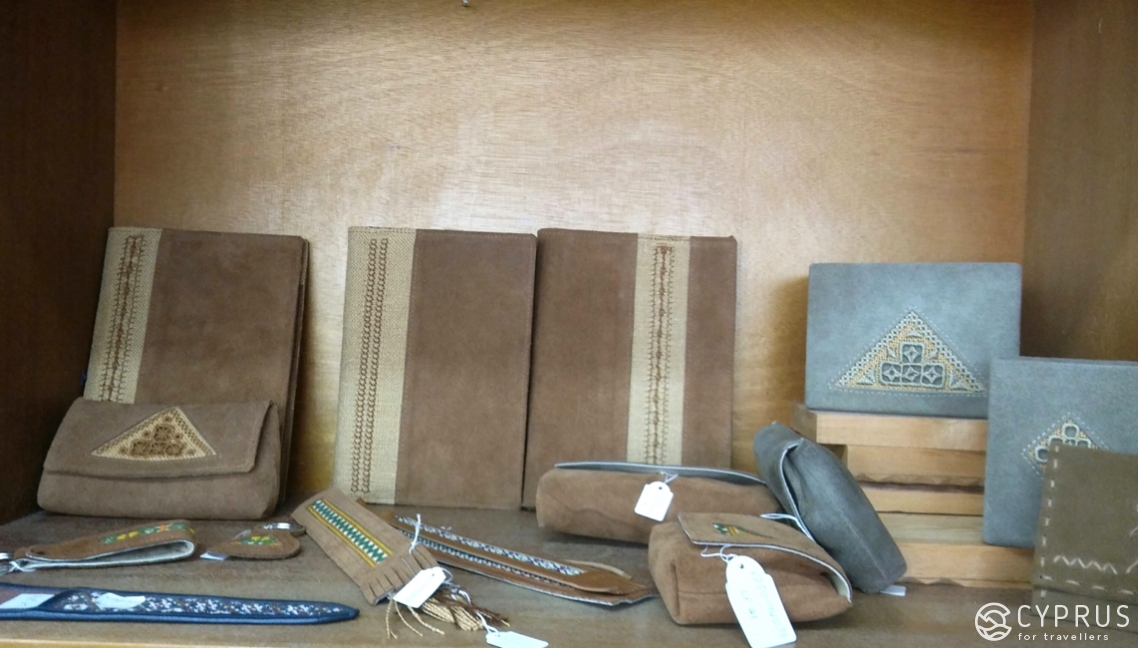
The eighth and final workshop: elements of the national dress (male and female) are fashioned here, parts of which you can see in the museum’s display cases, on mannequins and dolls. Experts say that the exact reason for why Cypriots dressed like this remains undiscovered. It is well known, however, that when creating a silhouette for types of national dress and their accompanying details and elements, an important role was played by the island’s climate, its location and by how each region’s history had different influences and traditions.
For instance, a distinctive component of the men’s traditional folk dress “karpasitiki” or “paphitiki” were wide, folded trousers (vraka) and vests.
Types of female and male dress: urban and rural designs, as well as “mixed”, which were accepted in large villages: during weddings, women wore the female urban dress known as “Amalia” (a silk skirt, a laced vest “to the waist” with long sleeves and a blouse). This was in contrast to rural attire, which was worn on weekdays or for other festivals. For more information on rural attire, see here.
The Museum
The culmination of your tour will take place in the exhibition hall (also the Handicrafts Museum): this rich and varied exhibition will once again allow you to scan the abundance of skills and techniques possessed by the locals on the island, and marvel at their beauty. The same carved wooden furniture, the main elements of which, despite the family’s income level, were chairs, a table, a bed and of course, a large chest — in which the young wife would have brought her dowry to her husband’s house.
All types of items traditionally produced on the island are on display in this small exhibit. Here you will encounter the famous “koukoumares” jugs (Ammochostos region) shaped like a woman’s figure, “striped” fabrics (the panels were 1,20 and 90 cm in width) and red “lefkoridzhatiko”. You can find all types of embroidery and lacework, domestic utensils (ceramics and hardware), items adorned in chandeliers, as well as carved glass pictures, decorative murals — you name it…

As well as visiting tourists, school groups are also brought here to the exhibitions.
I’ll say once again, practically everything we’ve seen in the Centre today can be purchased in original or contemporary form from the showroom located to the right of the main entrance. Everything is of exceptionally high quality, produced by hand and in line with the ancient techniques once used. Many possess the actual designs used nowadays.
A reminder: for those who’ve decided to open themselves to this world of Cypriot folk crafts and try their hand at mastering any of the given techniques, you’ll need to approach the information stand in the hall.
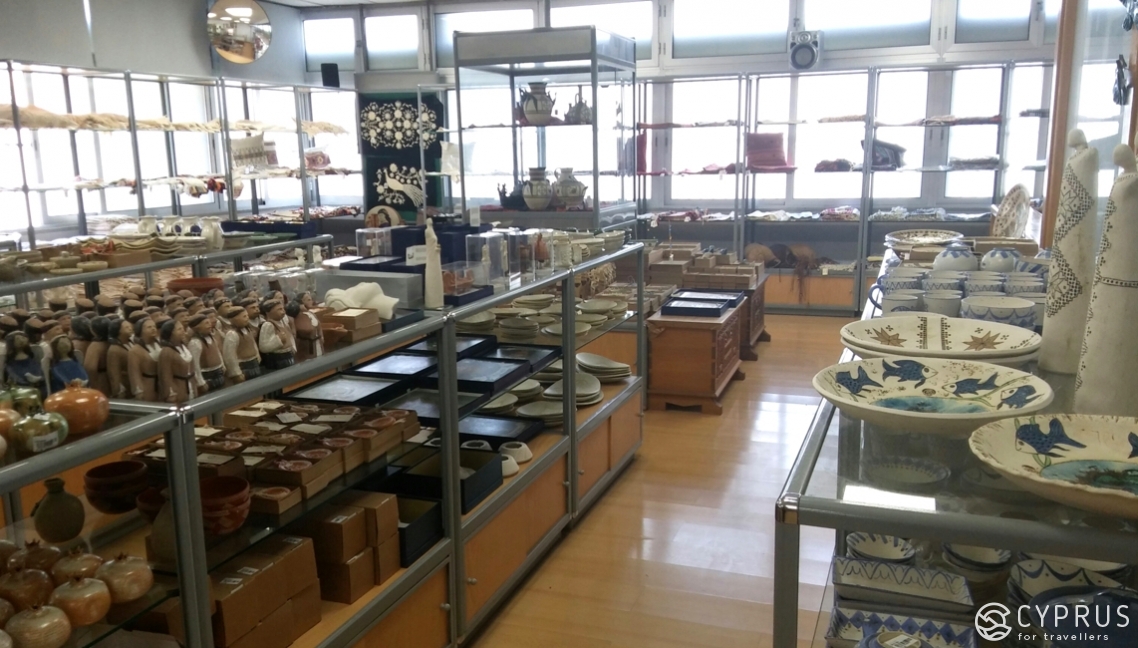
As I finish, on behalf of the Editorial staff at cyprusfortravellers.net, I’d like to express my sincere gratitude to the management and staff of the Centre of crafts, for all their help in preparing it; I also hope for further fruitful cooperation between us.
Handicrafts Centre Address: Atalassa Avenue, 186, Nicosia Centre
Telephone: +357 22305024
Stay with us and see you next time for more discoveries!
[1] For more details, please see here.
[2] As you know from our articles — Lefkara and The Encyclopaedia of Crafts — the thread used by the female embroiderers of Lefkara traditionally came in three colours: white, cream and olive-brown. These were involved in the production of table cloths, napkins, curtains, pillowcases and others, which are in huge demand today.
[3] I was told that the stages of “extracting” and working with the precious silk thread are demonstrated in the course of the September festival in Ayia Napa. By the way, you can buy ready-made items of Cypriot silk (scarves) from the Centre shop. They’re not cheap, but now we know why.
[4] To form the raw thread for future yarns, several threads are always joined together. This process is aided by natural sericin (the silkworms develop this protein contained within the silk), which reliably binds the ends together. The overall length of the cocoon thread can total from 300 metres to almost 1.5 kilometres!

